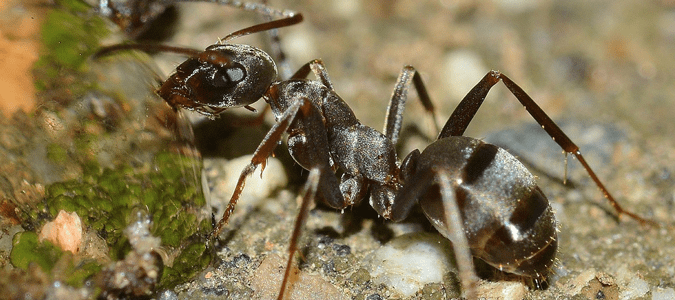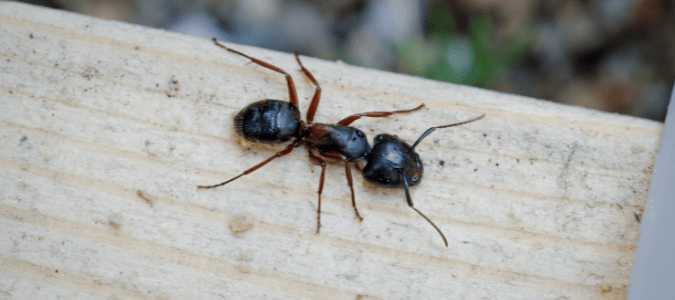Finding ants in your home can be shocking and gross. People find them most often in the kitchen, since that’s where most types of ants seek the food and water they need to survive indoors. But you might find them in other rooms, too. Ants are opportunistic. That means wherever they can get inside, they will. Learning how to prevent ants from infesting your home is an important part of controlling these pests. Fortunately, there are several things you can do to keep ants away from your home and property.
Ants are attracted to places where they can safely build a nest and reproduce. They also need to be able to find enough water and food to support their colony. Since they are so tiny—some types are less than an eighth of an inch long—they can get into our homes through very tiny cracks. That’s why preventing ants is a combination of keeping them out of your home and eliminating the things they’re attracted to.
Here are things you can do to prevent ants from being attracted to your home:
- Keep an eye out for scout ants. At the first scent of food, ants send out scouts to investigate. If you spot scout ants, that means there is an active nest nearby. The scouts are looking for sustenance to feed their colony. This means it’s time to get serious about
- Keep your kitchen clean. Wipe up spills and crumbs on tabletops, counters and floors as soon as they happen. Clean up dirty dishes instead of leaving them in the sink to draw pests in search of food. To keep ants and other insects away, it’s important to clean the kitchen after every use.
- Keep food in well-sealed containers. In the fight against pests, air-tight containers are essential for keeping ants out of foods on your counters or in the pantry. This also goes for pet food.
- Seal off any cracks or gaps letting ants into the home. Ants come into our homes from outside through any tiny crack in the exterior wall. They can also come in through gaps around doors, windows, vents or light fixtures. Sealing off these gaps, even tiny ones, is important in trying to prevent ants from getting inside. Apply caulk along cracks to keep ants out.
- Repair any water leaks, including leaky pipes or faucets. Pests access indoor leaks for the water they need to survive, but that’s not the only reason to repair leaks. Carpenter ants also love nesting in soft, damp wood. They might infest areas around the bathtub, shower or kitchen sink if an ongoing leak has led to water-damaged wood.
- Repair rotting decks, fences and other wooden structures, and clear away dead tree stumps and limbs. Since carpenter ants prefer to build nests in damp wood, damaged wood outdoors will also need to be removed or repaired. Clearing dead wood off your property will help in the fight against ants. So will repairing any rotten wood structures around your home. Damaged fences and decks are prime candidates for rotten wood that harbors carpenter ants.
While ants send out workers as scouts to find food for the colony, they build their nests in hidden places. They might nest within a wall void, inside rotting wood, or in soil outside. It can be tough to figure out where an ant colony is located. It can also be hard to find the crack or opening that pests are using to get inside your house.
Not to mention, it’s tough figuring out what kind of ants are infesting your home. But determining the type of ants you’re seeing is essential to figuring out the best ways to get rid of them. Different types of ants are attracted to different kinds of foods and nesting areas. They also require different products and techniques to get rid of them.
For this reason, lots of people find it easiest to contact a pest control professional to deal with an ant problem. A pro can figure out what type of ants are infesting your home. They can locate the colony (or colonies, if there are more than one), and determine the best treatment plan to get rid of the ants. They can also schedule follow-up visits to inspect your home and property to make sure the ants don’t return.
Odorous House Ants Versus Carpenter Ants
Odorous house ants and carpenter ants are two types of ants that people commonly find infesting their homes or property. But if you aren’t an insect expert, you may not know how to tell what type of ant you’re dealing with. Fortunately, there are several differences between odorous house ants vs. carpenter ants that can help you determine which one you’re seeing. Knowing what type of pest you’re dealing with will help you figure out the best ways to keep them away.
How to Identify Odorous House Ants
The odorous house ant, pictured above, got its name from the smell they give off when they are stepped on or crushed. It’s a strong, unpleasant smell that many people describe as being similar to the smell of rotten coconut. This is why odorous house ants are also known as coconut ants. Some people also just call them stink ants.
That distinctive smell is one of the ways to identify these pests, but there are several other characteristics that distinguish these from carpenter and other types of ants. One characteristic is their behavior when they feel threatened. Odorous house ants tend to travel in lines along the edges of carpets or baseboards. If you disturb them, they’ll start moving around erratically with their abdomens pointed upward.
Like other types of insects, there are several different kinds of adult odorous house ants that together make up a colony. The winged ants are the reproductives that swarm in spring and early summer, mate, and form new colonies. You might see these in your home if odorous house ants are nesting someplace indoors.
You’re more likely to see the workers, which don’t have wings. The workers are black and very small—just an eighth of an inch long. These are the ants sent out as scouts to find food. Odorous house ants eat sweet, sugary foods. This is why it’s so important to clean up spills and crumbs, so they won’t draw pests.
If you see several odorous house ant workers indoors, you can bet there’s a colony someplace nearby. It’s most likely outside, and the ants are getting inside through a crack in an exterior wall. They also might be accessing the indoors through a crack in the foundation.
How To Get Rid of Odorous House Ants
The most effective way to get rid of ants is to find their colony and destroy it. Finding odorous house ant colonies can be hard, since they usually find hidden spots to build them. These ants like to nest in wall voids or under flooring or carpets. They might also nest behind wall paneling. They also build nests outside and come indoors when it’s raining out. Outdoors, they build colonies in lots of places—in the soil, for example, in mulch, or in fallen tree limbs.
If you come across a colony inside your house, you can vacuum it up and get rid of the contents of your vacuum. But this may not deal with the problem completely, since not all the ants are present in the colony at once. In most cases, it’s easiest to contact a pest control professional for help. This is the most efficient and thorough way to get rid of these pests. A pro can also find where these ants come in from outside and seal off their entrance points.
How to Identify Carpenter Ants
Carpenter ants are big black ants that are quite a bit larger than odorous house ants. Their size is one of the main ways to identify carpenter ants. Adults range from a quarter-inch to half an inch long. Their bodies are usually either black or both black and red.
The reproductive carpenter ants are the swarmers. These are the adults with wings that swarm out of the colony in spring and summer to mate and start new colonies. People sometimes see winged carpenter ants indoors during swarming season. They might also see the wingless worker ants out foraging for food.
How To Get Rid of Carpenter Ants
To get rid of carpenter ants, you’ll need to get rid of the damp wood they are attracted to for nesting purposes. This will likely mean fixing water leaks or drainage problems that lead to damp wood structures in and around the home. If you have an ongoing leak around a sink, tub or shower, for example, carpenter ants might nest in the wet wood within the walls. Outside, clogged gutters or drainage problems on the ground can cause rotting decking or trim wood. These are also prime spots for carpenter ants to build nests.
There are other techniques for getting rid of carpenter ants. If they are nesting someplace indoors, you can drill tiny holes in the wall or baseboard near their colony. These holes are for puffing boric acid dust into the space where the colony lives. Boric acid is a powder that kills ants and other insect pests.
Sometimes, carpenter ants are indoors only for food foraging purposes. They actually live outside, maybe in a rotting tree stump or log. In this case, their access points into the home will need to be blocked off. Look for cracks or gaps in the foundation or exterior walls. Carpenter ants can also get inside through small cracks around vents, light fixtures, windows or doors. Fixing or caulking these will keep pests out.
If you have carpenter ants, your best bet may be to hire a pest control professional to handle the problem. A pro can tailor a multi-point approach to getting rid of your ant problem and ensuring it doesn’t return.
ABC Can Control and Prevent Ants
Dealing with an ant problem can be extremely frustrating. Instead of trying to control or prevent ants on your own, contact ABC Home & Commercial Services. Our highly trained professionals will create a custom pest treatment plan, so you don’t have to worry about these creatures.


